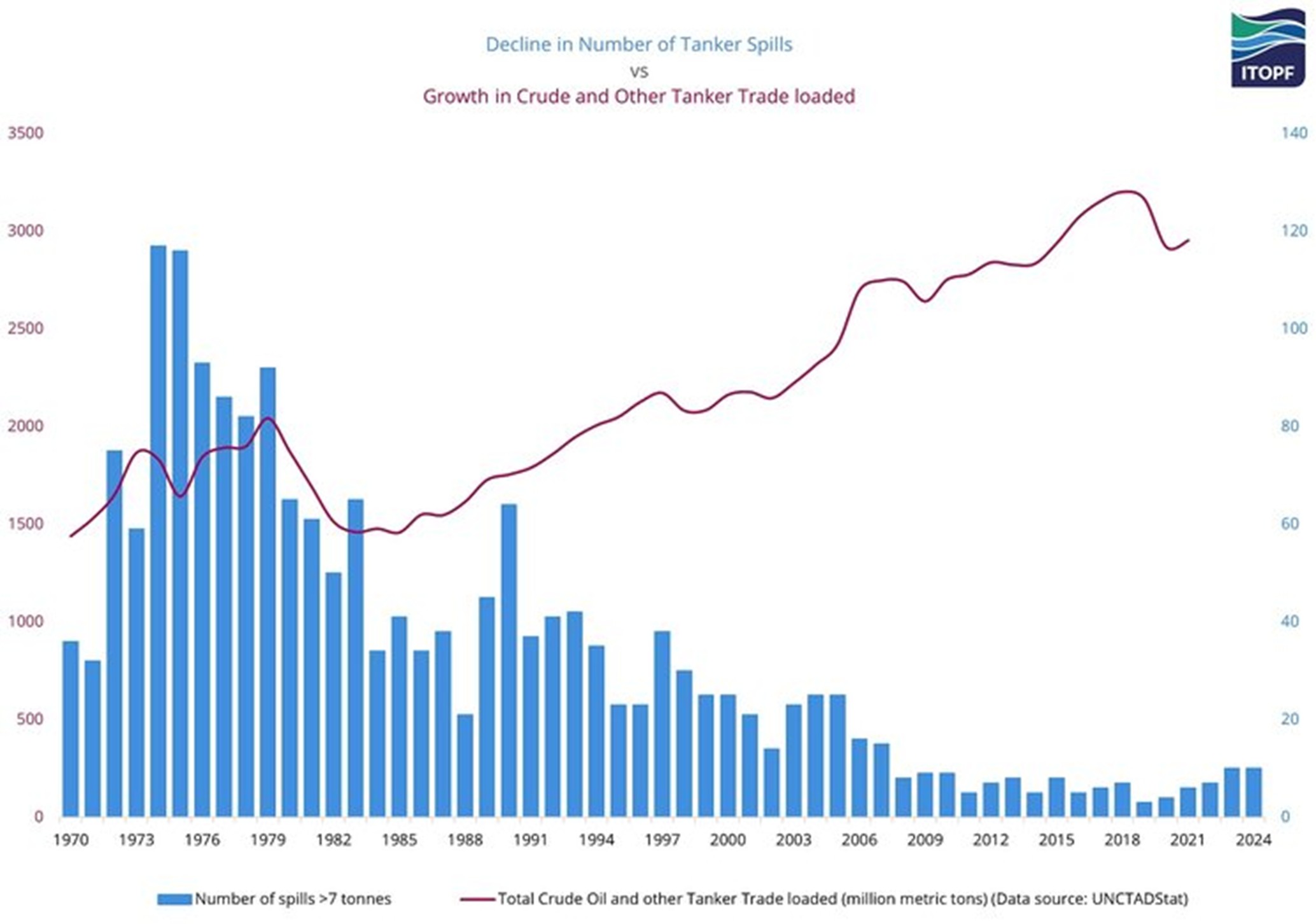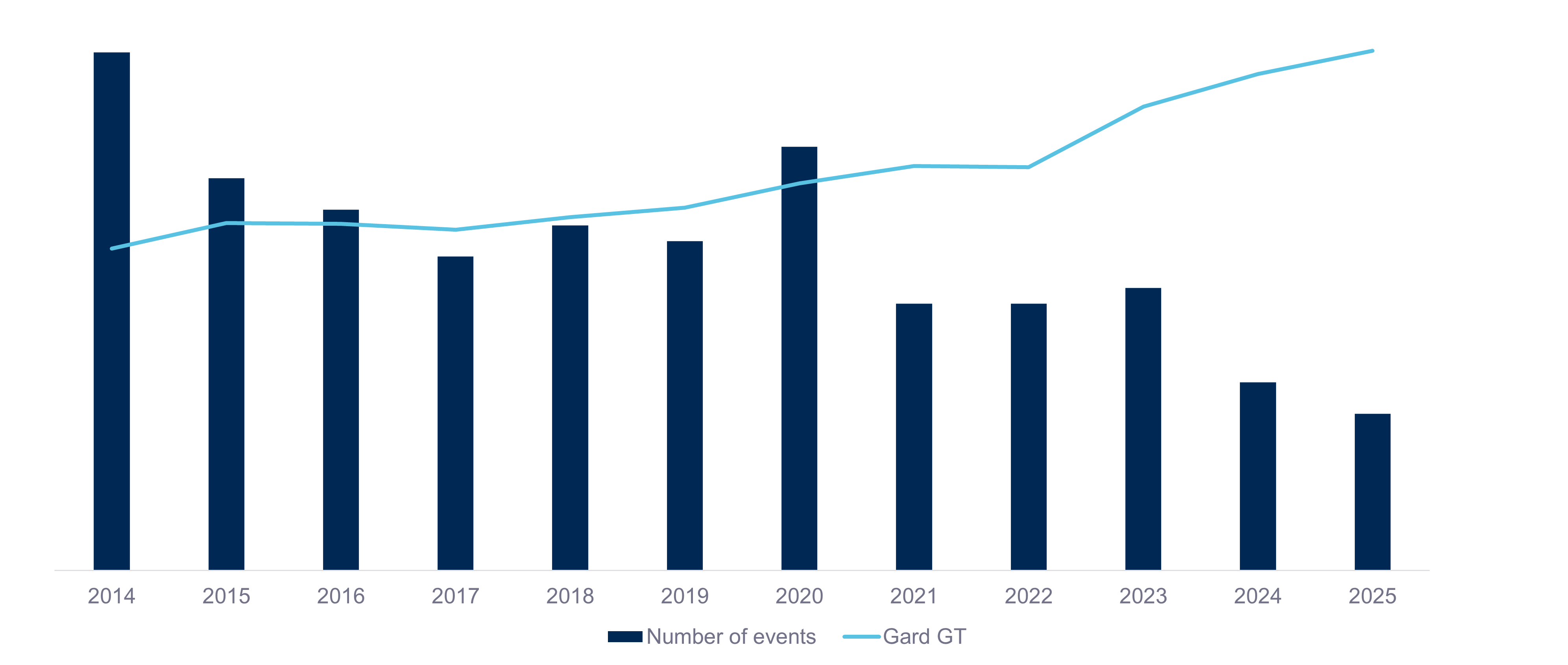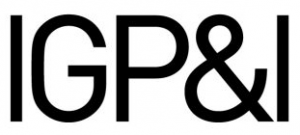From historic oil spills to the growing problem of plastic nurdles, the story of marine pollution shows both progress and gaps. On UN World Maritime Day, we take a closer look at the successes, the setbacks and some of the lessons learned along the way.

Ship source pollution – learning from experience
Published 25 September 2025
25 September is the UN World Maritime Day, and the theme in 2025 is “Our Ocean, Our Obligation, Our Opportunity”. In recognition, we are taking a closer look at accidental pollution – a subject of concern both to the public and to P&I insurers like Gard that insure shipowners against pollution liabilities. Let’s review both the good news and the bad, as well as the lessons learned over the past few decades.
The good news: improved regulations and dramatic reduction in oil spills
In March 1967, the supertanker Torrey Canyon ran aground off Britain’s Cornish coast and spilled an entire cargo of crude oil – some 80,000 tons that spread along the British and French coasts. The disaster resulted in two international liability and compensation treaties: The International Convention on Civil Liability for Oil Pollution Damage 1969 (CLC 69) and the International Convention on the Establishment of an International Fund for Compensation for Oil Pollution Damage 1971 (1971 FUND). The CLC established strict liability of shipowners for spills of persistent oil carried as cargo and the requirement for compulsory insurance.
The CLC and Fund conventions established a cost sharing between the shipowner and their P&I insurers on the one hand and the oil receivers on the other. This regime exists today in the form of the 1992 International Oil Pollution Compensation Fund and the accompanying 2003 Supplementary Fund. The Fund Conventions provide compensation in excess of the CLC limitation amount based on ship tonnage that makes up the first tier of compensation.
Funding for clean-up and compensation for tanker spills is effectively split between liability insurers for the first tier and oil receivers as contributors to the Fund. To date, 151 States have ratified the current version of the CLC – the 1992 Civil Liability Convention, and 122 States have ratified the 1992 Fund Convention.
Since a high in the 1970s, the incidence rate of tanker spills has dropped steadily despite a rising volume in carriage of crude, petroleum and gas.

Source ITOPF Oil Tanker Spill Statistics 2024
The reduction is likely due to improved international conventions and regulations, increased focus on quality from shipowners and oil companies and implementation of new ship designs. The one caveat to this positive trend is the substantial increase of the “shadow fleet” carrying Russian and Iranian crude oil to countries that do not have sanctions in place. These tankers now make up as much as 20% of the total tanker fleet, according to Lloyd’s List. They also tend to be older and are insured outside of the IG Group.
Spills of hydrocarbon bunker oil from non-tankers is similarly covered by international convention with many of the same features as the CLC including strict liability and mandatory insurance (provided by P&I Clubs). The International Convention on Civil Liability for Bunker Oil Pollution Damage was adopted in 2001 and came into force in 2008. There are no readily available statistics showing bunker spills globally. However, Gard’s own data shows a similar pattern in the reduction of bunker spills while the total tonnage of non-tanker vessels in the Gard portfolio has grown (see figure below).

Number of bunker pollution events vs. Gard fleet GT (Excluding tankers)
With decarbonisation and increased use of alternative fuels on the horizon, we can expect further reduction in persistent oil spills from non-tanker vessels in the future.
The bad news: nurdle pollution
Plastic pellets often called “nurdles” are about the size and shape of a lentil and are the building blocks of nearly all plastic products. Petrochemical companies produce nurdles from oil and gas resulting in various polymers that can be melted and then moulded or extruded to form products ranging from plastic bags and food packaging to plumbing pipes.
Durable plastic products enable our modern lifestyle – we don’t see so many wooden airplanes out there after all. That said, about 40% of the 400,000,000 metric tons of plastic produced annually is used in single use products like food packaging and drink bottles fuelling a plastic waste crisis in many parts of the world. It is estimated that no more than 10% of plastic produced is recycled. While recycling is laudable, it has no effect on the number of nurdles produced as recycling ends with the production of nurdles which can then be used to create new products. Unlike petroleum based fuels, plastic products are estimated to continue to increase – meaning more nurdles in transit.
Nurdles are transported by truck, train and ship to distributers or plastic product manufacturers. Marine shipping usually happens by container (although there is no current restriction to carriage in bulk). ITOPF reckons that a single container holds about 1 billion nurdles.
Nurdles in the marine environment
Like all plastic litter, most nurdles reach the sea from land sources. Acute terrestrial spills often occur during transit due to truck or train accidents. Spills at sea occur when containers are pierced or lost overboard due to casualties. For a list of acute terrestrial and marine spills see “Mapping the Global Plastic pellet Supply Chain” (Appendix E).
In 2020 about 13 MT of polypropylene nurdles spilled from a single damaged container aboard the ro-ro vessel Trans Carrier affecting about 1,000 km of the coastline in Norway and Sweden. Clean-up took more than a year. Also in 2020, – six containers of low-density polyethylene nurdles were lost off Cape Agulhas in South Africa. Dispersed in the strong Agulhas current, the spill affected some 1,600 km of coastline.
By far the worst nurdle spill occurred in May 2021 off Colombo, Sri Lanka after the X-Press Pearl caught fire and partially sank. The vessel was coming from India to Sri Lanka with 1,377 containers on board, 422 of which contained nurdles of various polymers. The nurdles dispersed over 300 kilometers of the Sri Lanka coastline. The clean-up removed the high concentrations of nurdles from the affected beaches.
We have learned from these events that once in the ocean, low density nurdles (polypropylene and polyethylene) float on the surface, allowing them to spread over large areas by wind and currents. Some will wash up on beaches, others will continue to circulate in ocean currents. Even after extensive cleaning nurdles in smaller concentrations may re-emerge in the same location due to currents, weather and wave action. This makes clean-up laborious and expensive. It is accepted that only a portion of spilled nurdles can be found and removed despite best efforts. While nurdles are not acutely toxic, the impacts on marine life are wide, the main ones being ingestion, leaching of additives and acting as vectors for persistent organic pollutants, microbes and invasive (micro)organisms.
Since nurdles persist in the environment and cannot fully be removed, there is a clear need for regulating how they are transported to reduce the risk of spills.
On the international regulatory front
In March 2022, the UN resolved to develop an international treaty on plastic pollution including the marine environment. The Intergovernmental Negotiating Committee (INC) was formed to develop a treaty text to address the full life cycle of plastic, including production, design and disposal. The draft included a provision requiring “each party to take measures to prevent reduce and where possible eliminate … releases and leakages of plastic pellets, flakes and powders to the environment and aquatic systems…”. Unfortunately, the final INC negotiations held in Geneva in August 2025, failed to reach an agreement.
In spite of this, there has been progress through the International Maritime Organization (IMO) to address carriage of nurdles on vessels as well as clean-up following a spill. In April 2024, the IMO – adopted voluntary recommendations for carriage of nurdles in containers. In addition, the Guidelines on clean-up of plastic pellets from ship-source spills were approved by the IMO Marine Environment Protection Committee (MEPC82) in October 2024.
The IMO Subcommittee on Pollution Prevention and Response (PPR) has considered three proposals for mandatory regulation – two of which would have resulted in designation of nurdles as a harmful substance, requiring adequate packaging, consistent marking of package contents and inclusion in the dangerous goods manifest. At the PPR meeting in February 2024, no consensus on the way forward was reached, and further input was requested. At present, there are no mandatory shipping requirements, and it may take a long time before international regulations are adopted.
Looking at the history of international regulation following the Torrey Canyon oil spill, a clear lesson is that progress is best made when stakeholders cooperate within the international arena. Leaving regulation at the state or regional level is not workable for a global industry.



